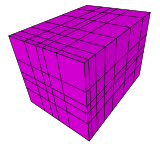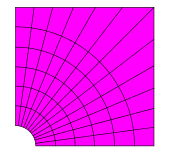Regular grid

A regular grid is a tessellation of n-dimensional Euclidean space by congruent parallelotopes (e.g. bricks).[1] Grids of this type appear on graph paper and may be used in finite element analysis as well as finite volume methods and finite difference methods. Since the derivatives of field variables can be conveniently expressed as finite differences,[2] structured grids mainly appear in finite difference methods. Unstructured grids offer more flexibility than structured grids and hence are very useful in finite element and finite volume methods.
Each cell in the grid can be addressed by index (i, j) in two dimensions or (i, j, k) in three dimensions, and each vertex has coordinates in 2D or in 3D for some real numbers dx, dy, and dz representing the grid spacing.
Related grids
A Cartesian grid is a special case where the elements are unit squares or unit cubes, and the vertices are integer points.
A rectilinear grid is a tessellation by rectangles or parallelepipeds that are not, in general, all congruent to each other. The cells may still be indexed by integers as above, but the mapping from indexes to vertex coordinates is less uniform than in a regular grid. An example of a rectilinear grid that is not regular appears on logarithmic scale graph paper.
A curvilinear grid or structured grid is a grid with the same combinatorial structure as a regular grid, in which the cells are quadrilaterals or cuboids rather than rectangles or rectangular parallelepipeds.
| Examples of regular grids | ||||||||
|---|---|---|---|---|---|---|---|---|
|
See also
References
- ↑ Uznanski, Dan. "Grid.". From MathWorld--A Wolfram Web Resource, created by Eric W. Weisstein. Retrieved 25 March 2012.
- ↑ J.F. Thompson, B. K . Soni & N.P. Weatherill (1998). Handbook of Grid Generation. CRC-Press. ISBN 978-0-8493-2687-5.




